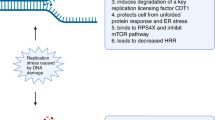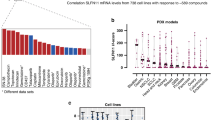Abstract
The response rate of topotecan, as a second-line chemotherapeutic drug for small cell lung cancer, is ~20%. DNA/RNA helicase SLFN11 (schlafen family member 11), a member of the Schlafen (SLFN) family, is a crucial determinant of response to many DNA damaging agents, expression of SLFN11 tends to augment the antitumor effects of the commonly used DNA-targeting agents. In the present study we investigated how SLFN11 expression regulated the sensitivity of small cell lung cancer to topotecan. We showed that SLFN11 expression levels were positively associated with the sensitivity to topotecan in a panel of seven SCLC cell lines. Topotecan treatment induced different patterns of the DNA response network in SCLC cells: DNA damage response (DDR) was more prominently activated in SLFN11-deficient SCLC cell line H82 than in SLFN11-plentiful SCLC cell line DMS273, whereas topotecan induced significant accumulation of p-Chk1, p-RPA2 and Rad51 in H82 cells, but not in DMS273 cells. We unraveled that SLFN11 expression was highly negatively correlated to the methylation of the SLFN11 promoter. HDAC inhibitors FK228 and SAHA dose-dependently increased SLFN11 expression through suppressing DNA methylation at the SLFN11 promoter, thereby sensitizing SCLC cells to topotecan. Finally, we assessed the methylation status of the SLFN11 promoter in 27 SCLC clinical specimens, and found that most of the clinical samples (24/27) showed DNA methylation at the SLFN11 promoter. In conclusion, it is feasible to combine topotecan with FK228 to improve the response rate of topotecan in SCLC patients.
Similar content being viewed by others
Log in or create a free account to read this content
Gain free access to this article, as well as selected content from this journal and more on nature.com
or
References
Byers LA, Rudin CM. Small cell lung cancer: where do we go from here? Cancer. 2015;121:664–72.
Waqar SN, Morgensztern D. Treatment advances in small cell lung cancer (SCLC). Pharmacol Ther. 2017;180:16–23.
Morabito A, Carillio G, Daniele G, Piccirillo MC, Montanino A, Costanzo R, et al. Treatment of small cell lung cancer. Crit Rev Oncol Hematol. 2014;91:257–70.
Horita N, Yamamoto M, Sato T, Tsukahara T, Nagakura H, Tashiro K, et al. Topotecan for relapsed small-cell lung cancer: systematic review and meta-analysis of 1347 patients. Sci Rep. 2015;5:15437.
Murai J, Tang SW, Leo E, Baechler SA, Redon CE, Zhang H, et al. SLFN11 blocks stressed replication forks independently of ATR. Mol Cell. 2018;69:371–84 e6.
Ballestrero A, Bedognetti D, Ferraioli D, Franceschelli P, Labidi-Galy SI, Leo E, et al. Report on the first SLFN11 monothematic workshop: from function to role as a biomarker in cancer. J Transl Med. 2017;15:199.
Berns K, Berns A. Awakening of “Schlafen11” to tackle chemotherapy resistance in SCLC. Cancer Cell. 2017;31:169–71.
Tian L, Song S, Liu X, Wang Y, Xu X, Hu Y, et al. Schlafen-11 sensitizes colorectal carcinoma cells to irinotecan. Anticancer Drugs. 2014;25:1175–81.
Liu Y, Burness ML, Martin-Trevino R, Guy J, Bai S, Harouaka R, et al. RAD51 mediates resistance of cancer stem cells to PARP inhibition in triple-negative breast cancer. Clin Cancer Res. 2017;23:514–22.
Murai J, Thomas A, Miettinen M, Pommier Y. Schlafen 11 (SLFN11), a restriction factor for replicative stress induced by DNA-targeting anti-cancer therapies. Pharmacol Ther. 2019;201:94–102.
He T, Zhang M, Zheng R, Zheng S, Linghu E, Herman JG, et al. Methylation of SLFN11 is a marker of poor prognosis and cisplatin resistance in colorectal cancer. Epigenomics. 2017;9:849–62.
Zoppoli G, Regairaz M, Leo E, Reinhold WC, Varma S, Ballestrero A, et al. Putative DNA/RNA helicase Schlafen-11 (SLFN11) sensitizes cancer cells to DNA-damaging agents. Proc Natl Acad Sci USA. 2012;109:15030–5.
Lok BH, Gardner EE, Schneeberger VE, Ni A, Desmeules P, Rekhtman N, et al. PARP inhibitor activity correlates with SLFN11 expression and demonstrates synergy with temozolomide in small cell lung cancer. Clin Cancer Res. 2017;23:523–35.
Pietanza MC, Waqar SN, Krug LM, Dowlati A, Hann CL, Chiappori A, et al. Randomized, double-blind, phase II study of temozolomide in combination with either veliparib or placebo in patients with relapsed-sensitive or refractory small-cell lung cancer. J Clin Oncol. 2018;36:2386–94.
Tang SW, Thomas A, Murai J, Trepel JB, Bates SE, Rajapakse VN, et al. Overcoming resistance to DNA-targeted agents by epigenetic activation of Schlafen 11 (SLFN11) expression with class I histone deacetylase inhibitors. Clin Cancer Res. 2018;24:1944–53.
Gardner EE, Lok BH, Schneeberger VE, Desmeules P, Miles LA, Arnold PK, et al. Chemosensitive relapse in small cell lung cancer proceeds through an EZH2-SLFN11 axis. Cancer Cell. 2017;31:286–99.
Polley E, Kunkel M, Evans D, Silvers T, Delosh R, Laudeman J, et al. Small cell lung cancer screen of oncology drugs, investigational agents, and gene and microRNA expression. J Natl Cancer Inst. 2016;108:1–11.
Wang H, Hong B, Li X, Deng K, Li H, Yan Lui VW, et al. JQ1 synergizes with the Bcl-2 inhibitor ABT-263 against MYCN-amplified small cell lung cancer. Oncotarget. 2017;8:86312–24.
Peng Y, Wang L, Wu L, Zhang L, Nie G, Guo M. Methylation of SLFN11 promotes gastric cancer growth and increases gastric cancer cell resistance to cisplatin. J Cancer. 2019;10:6124–34.
Deng K, Shen J, Wang W, Li M, Li H, Chen C, et al. Sodium chloride (NaCl) potentiates digoxin-induced anti-tumor activity in small cell lung cancer. Cancer Biol Ther. 2019;20:52–64.
Mu Y, Lou J, Srivastava M, Zhao B, Feng XH, Liu T, et al. SLFN11 inhibits checkpoint maintenance and homologous recombination repair. EMBO Rep. 2016;17:94–109.
Li D, Marchenko ND, Moll UM. SAHA shows preferential cytotoxicity in mutant p53 cancer cells by destabilizing mutant p53 through inhibition of the HDAC6-Hsp90 chaperone axis. Cell Death Differ. 2011;18:1904–13.
Foggetti G, Ottaggio L, Russo D, Mazzitelli C, Monti P, Degan P, et al. Autophagy induced by SAHA affects mutant P53 degradation and cancer cell survival. Biosci Rep. 2019;39:BSR20181345.
Imai H, Yamada Y, Minemura H, Sugiyama T, Kotake M, Kaira K, et al. Topotecan monotherapy for the treatment of relapsed small cell lung cancer in elderly patients: a retrospective analysis. Thorac Cancer. 2018;9:1699–706.
Murai J, Feng Y, Yu GK, Ru Y, Tang SW, Shen Y, et al. Resistance to PARP inhibitors by SLFN11 inactivation can be overcome by ATR inhibition. Oncotarget. 2016;7:76534–50.
Robertson KD, Ait-Si-Ali S, Yokochi T, Wade PA, Jones PL, Wolffe AP. DNMT1 forms a complex with Rb, E2F1 and HDAC1 and represses transcription from E2F-responsive promoters. Nat Genet. 2000;25:338–42.
Fuks F, Burgers WA, Godin N, Kasai M, Kouzarides T. Dnmt3a binds deacetylases and is recruited by a sequence-specific repressor to silence transcription. EMBO J. 2001;20:2536–44.
Acknowledgements
This study was supported by National Natural Science Foundation of China (81972191 and 81672647), Science and Technology Major Project of Anhui Province (18030801140), and the 100-Talent Program of Chinese Academy of Sciences. A portion of this work was supported by the High Magnetic Field Laboratory of Anhui Province. We thank members of Wenchu Lin’s laboratory for critical reading of the paper and helpful discussions. We thank Dr Xiao-dong Mei from the First Affiliated Hospital of USTC, Division of Life Sciences and Medicine, University of Science and Technology of China for providing us with the clinical specimens for investigation.
Author information
Authors and Affiliations
Contributions
WCL conceived and designed the study. YPY, LYM performed experiments and acquired the data. XTL performed flow cytometry analysis. GZC performed statistical analyses. JHH collected clinical information and performed correlation analyses; YPY wrote the original draft. WCL wrote and reviewed the paper. All authors reviewed the paper and approved the conclusions.
Corresponding author
Ethics declarations
Competing interests
The authors declare no competing interests.
Supplementary information
Rights and permissions
About this article
Cite this article
Yin, Yp., Ma, Ly., Cao, Gz. et al. FK228 potentiates topotecan activity against small cell lung cancer cells via induction of SLFN11. Acta Pharmacol Sin 43, 2119–2127 (2022). https://doi.org/10.1038/s41401-021-00817-y
Received:
Accepted:
Published:
Issue date:
DOI: https://doi.org/10.1038/s41401-021-00817-y
Keywords
This article is cited by
-
From predictive biomarker to therapeutic target: the dual role of SLFN11 in chemotherapy sensitivity
Cancer Chemotherapy and Pharmacology (2025)
-
SLFN11, far from being limited to responding to cancer DNA damage
Clinical and Experimental Medicine (2025)
-
HMGN1 loss sensitizes lung cancer cells to chemotherapy
Scientific Reports (2024)
-
Synergistic effect of a nonsteroidal anti-inflammatory drug in combination with topotecan on small cell lung cancer cells
Molecular Biology Reports (2024)
-
Darinaparsin (ZIO-101) enhances the sensitivity of small-cell lung cancer to PARP inhibitors
Acta Pharmacologica Sinica (2023)



